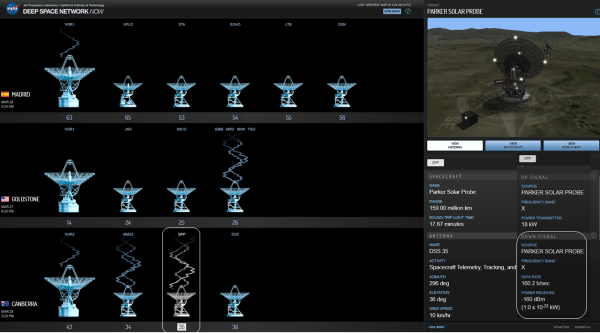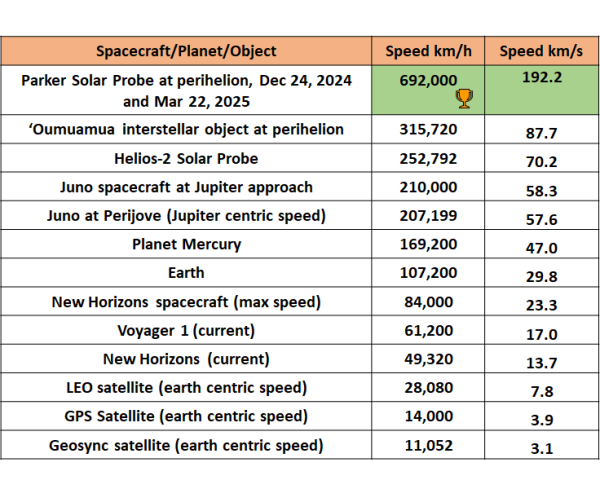Suche
Beiträge, die mit parker getaggt sind
The NASA Parker Solar Probe, 6 days after its 23rd close approach of the Sun, is now transmitting detailed spacecraft status to Earth via the 34 meter antenna of station 35 at the DSN site in Canberra.
Transmit/Receive band: X (~8 GHz)
Downlink data rate: 160.2 bps
Science data will be downloaded in a few days over the higher rate Ka-band link using the probe's 0.6-meter High Gain Antenna (HGA) dish, at data rates of 167 kbps and higher.
https://eyes.nasa.gov/apps/dsn-now/dsn.html
#Parker #ParkerSolarProbe
8/n
Transmit/Receive band: X (~8 GHz)
Downlink data rate: 160.2 bps
Science data will be downloaded in a few days over the higher rate Ka-band link using the probe's 0.6-meter High Gain Antenna (HGA) dish, at data rates of 167 kbps and higher.
https://eyes.nasa.gov/apps/dsn-now/dsn.html
#Parker #ParkerSolarProbe
8/n
Deep Space Network Now
The real time status of communications with our deep space explorersDeep Space Network Now
NASA’s Parker Solar Probe (PSP) still holds the record for the fastest spacecraft ever; its nearest rival, the Helios-2 Solar Probe, is not even close.
For comparison, the table below shows speeds for various spacecraft, planets and satellites. Speeds are Sun-centric unless otherwise noted.
#Parker #ParkerSolarProbe
7/n
For comparison, the table below shows speeds for various spacecraft, planets and satellites. Speeds are Sun-centric unless otherwise noted.
#Parker #ParkerSolarProbe
7/n
NASA’s Parker Solar Probe will make its 23rd close approach of the Sun tomorrow March 22, 2025 at 22:42 UTC.
At perihelion, it will be at a distance of just 6.1 million km from the solar surface, traveling at a speed of 692,000 km/h, matching its previous record set during perihelion 22 on Dec 24, 2024.
For comparison, the perihelion of planet Mercury is at 45.3 mil km.
https://parkersolarprobe.jhuapl.edu/
https://en.wikipedia.org/wiki/Parker_Solar_Probe
#Parker #ParkerSolarProbe #NASA
1/n
At perihelion, it will be at a distance of just 6.1 million km from the solar surface, traveling at a speed of 692,000 km/h, matching its previous record set during perihelion 22 on Dec 24, 2024.
For comparison, the perihelion of planet Mercury is at 45.3 mil km.
https://parkersolarprobe.jhuapl.edu/
https://en.wikipedia.org/wiki/Parker_Solar_Probe
#Parker #ParkerSolarProbe #NASA
1/n
Parker Solar Probe
In order to unlock the mysteries of the corona, but also to protect a society that is increasingly dependent on technology from the threats of space weather, Parker Solar Probe was sent to touch the Sun.Parker Solar Probe



